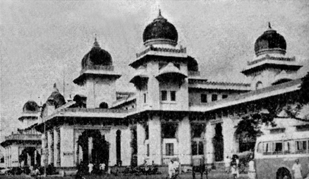
One of the most enduring and endearing landmarks of our city, the Egmore railway station, is 106 years old. It stands on a historic site, for this was where the East India Company converted a standing choultry into a fortified redoubt, early in the 18th Century. It later served as a sanatorium for soldiers and then in the 1800s as a Government Press. The Male and Female Orphan Asylums functioned from here when they moved out of Fort St George in the mid-18th Century. By the late 19th/early 20th Century, a part of this property was owned by Senjee Pulnee Andy (1831-1909). A graduate of the Madras Christian College, he became the first Indian to go abroad for a medical degree, qualifying at the University of St Andrew’s in 1860 and becoming a Fellow of the Royal College of Surgeons a year later. Returning to India, he was appointed Superintendent of Vaccinations, Government of Madras. He converted to Christianity in 1863 and established the Native/National Church of India, which proved to be short-lived. An avid Freemason, he helped establish the Lodge Carnatic in the city in 1883 of which he was the second Master.
Andy’s vast property in Egmore was eyed by the South Indian Railway Company (SIR) as a suitable location for its northern terminus. The SIR resulted from the amalgamation of three companies – the Great Southern Indian Railway Company (GSIRC) established in 1859, the Carnatic Railway Company (CRC) established in 1864, and the Pondicherry Railway Company Limited (PRC) established in the 1870s. The GSIRC operated in the Trichinopoly-Negapatam area while the CRC had its lines in the Conjeevaram-Arkonam region. The PRC was much smaller, limiting itself to eight miles near its headquarters. The SIR was founded in 1874 and took over all three lines.
From then till 1946, when the nationalisation of the railways began, the SIR was a private company, headquartered in Trichinopoly. Its Madras station was Egmore and a photograph in the Sir Robert Stanes collection, now with the Amalgamation Group, testifies to the presence of a station here by the 1880s. But it was only in the early 1900s that the SIR decided to build a proper terminus in the city and negotiations were opened with Pulney Andy. He proved to be a reluctant seller. Spread over 1.83 acres the property had buildings that he considered memorials to his late wife. He wanted them to be used for his Native Church. Also dear to him was an orchard that he had tended on the premises. But with the Collector of Madras bringing pressure to bear, he parted with the land in 1904 for Rs 100,000.
Work began on the station, considered to be larger than London’s Charing Cross, with dimensions of 300ft by 70ft. The design was by Henry Irwin and E. C. Bird. The contractor was T. Samynada Pillai of Bangalore who also constructed the Madura and Trichinopoly stations of the SIR. The Egmore station cost Rs. 17 lakh to build and was completed in 1908. It was one of the early instances of usage of concrete in Madras. The structure also had another first – incorporation of Dravidian motifs within the Indo-Saracenic genre. The station has had two extensions – one in 1930 and another in 1980. Rather surprisingly, the later addition is more in keeping with the original design than the earlier one – its pyramidal and truncated domes having been described as bulbous and squat and “far from an architectural masterpiece”. The elephant logo of the SIR can still be seen over the entrance porch. There were other attractions – a drive-in platform and a stained-glass-and-timber dream of a refreshment room, the latter operated by Spencer’s.
The SIR was amalgamated into the Indian Railways in 1951, becoming the latter’s Southern Railway, the ‘I’ on the SIR logo over the station being painted out to reflect the change. With its wooden stairways and vast cavernous interiors, Egmore remained a tranquil station till the 1980s when, with the population explosion and the burgeoning number of vehicles coming into it and the surroundings, it has become synonymous with chaos. The drive-in platform has vanished. And as for the refreshment room, its stained glass and wooden interior has been buried under tons of plywood and other accretions. The beauty of the station can now be detected only by the most determined observer. While congestion can be an excuse for the shoddy appearance of the station, there can be no forgiving the poor maintenance and lack of upkeep which point to a deeper and a normally common Indian malaise.
|

